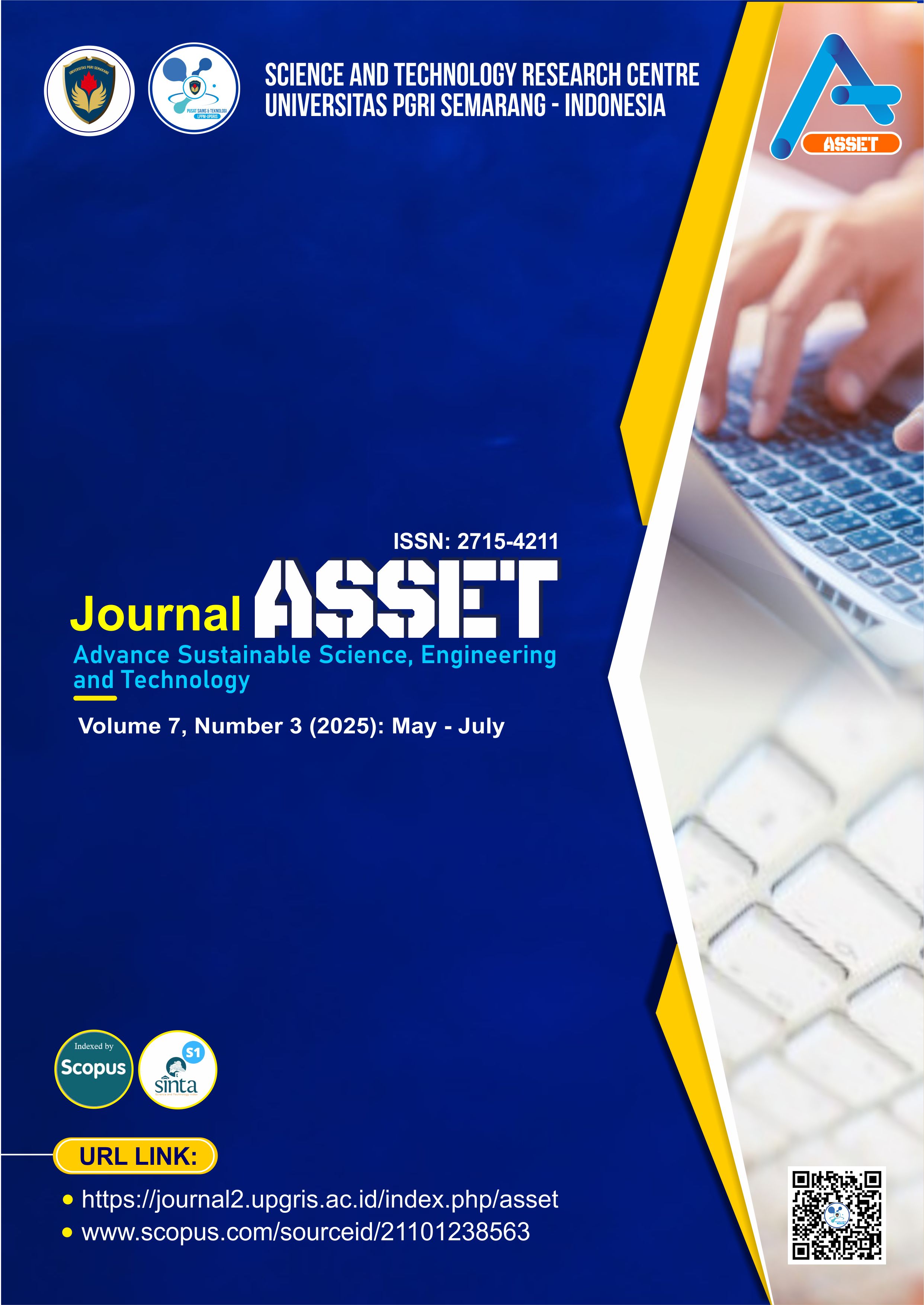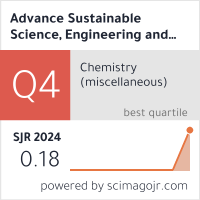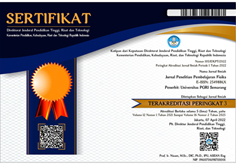“Demata 2.0”: An On-Device AI Assistive Technology for the Visually Impaired Integrating YOLOv10 and OCR
DOI:
https://doi.org/10.26877/asset.v7i4.2380Keywords:
assistive technology, on-device AI, optical character recognition, visual impairment, YOLOv10Abstract
Accessibility to printed materials and independent recognition of the environment remain key challenges for students with visual impairments. To address this issue, this study introduces Demata 2.0, a fully offline on device multimodal AI system. The system integrates Google ML Kit for Optical Character Recognition (OCR) and the YOLOv10 model via TensorFlow Lite for object detection. A mathematical distance algorithm in the RGB color space enables color identification. Evaluation showed that object detection achieved a mean average precision of 31.83%, with an average processing speed of 2–3 FPS. For OCR, the system recorded a Character Error Rate (CER) of 4.81% and a Word Error Rate (WER) of 10.71% on printed documents. The RGB algorithm also determined the closest possible color effectively. Overall, Demata 2.0 advances assistive technology by providing an efficient and practical blueprint for AI integration.
References
[1] Abadi RF, Pratama TY, Dewi CO. Penggunaan media ular tangga Braille dalam meningkatkan kemampuan mengenal bilangan angka 1-10 anak dengan hambatan penglihatan. Jurnal UNIK: Pendidikan Luar Biasa 2021;6:37. https://doi.org/10.30870/unik.v6i1.1186.3
[2] Maslahah S, Musayarah S, Alamsyah Sidik S, Febri Abadi R, Yhuda Pratama T, Tanjung Utami Y, et al. Pengembangan Modul Inovasi Pendidikan Berbasis Universal Design for Learning (UDL) yang Inklusif bagi Mahasiswa Disabilitas. Jurnal Unik: Pendidikan Luar Biasa 2023;8:1–8.
[3] Viner M, Singh A, Shaughnessy MF. Assistive technology to help students with disabilities. Research Anthology on Inclusive Practices for Educators and Administrators in Special Education, IGI Global; 2021, p. 579–600. https://doi.org/10.4018/978-1-6684-3670-7.ch033.
[4] Prystiananta NC, Noviyanti AI, Udhiyanasari KY. The Impact of Assistive Technologies in Enhancing English Learning Outcomes for Students with Disabilities: A Meta-Narrative Analysis. World Journal of English Language 2025;15:296–308. https://doi.org/10.5430/wjel.v15n2p296.
[5] Mashiata M, Ali T, Das P, Tasneem Z, Badal MFR, Sarker SK, et al. Towards assisting visually impaired individuals: A review on current status and future prospects. Biosens Bioelectron X 2022;12. https://doi.org/10.1016/j.biosx.2022.100265.
[6] Kela GP, Daga MG, Khandelwal R. Vision to Voice: An Advanced Blind Assistance System Integrating YOLOv3 and OCR Technologies for Enhanced Mobility. ICDT 2025 - 3rd International Conference on Disruptive Technologies, 2025, p. 1473 – 1476. https://doi.org/10.1109/ICDT63985.2025.10986482.
[7] Cho IJ, Park J, Bae H. A Computer Vision and Vibrohaptic Glove-Based Piano Learning System for the Visually Impaired. International Conference on Advanced Communication Technology, ICACT, 2025, p. 334 – 338. https://doi.org/10.23919/ICACT63878.2025.10936768.
[8] Bansal V, Joshi A, Aarsha VS, Shivali, Talwandi NS. VisionCane: A Comprehensive Review of an Intelligent Assistive Device for Object Detection and Real-Time Communication. Lecture Notes in Networks and Systems 2025;1408 LNNS:191 – 202. https://doi.org/10.1007/978-981-96-6297-5_15.
[9] Dube S, Bagde M, Bhagat J, Pardhi S, Ghosh M, Das D. Sound Vision: A Deep CNN Recursive Learning-Based Navigation Assistive Device for Divyang (Visually Impaired) Person. Lecture Notes in Networks and Systems 2025;1200:523 – 533. https://doi.org/10.1007/978-981-97-9926-8_40.
[10] Ikram S, Sarwar Bajwa I, Gyawali S, Ikram A, Alsubaie N. Enhancing Object Detection in Assistive Technology for the Visually Impaired: A DETR-Based Approach. IEEE Access 2025;13:71647 – 71661. https://doi.org/10.1109/ACCESS.2025.3558370.
[11] Doore SA, Istrati D, Xu C, Qiu Y, Sarrazin A, Giudice NA. Images, Words, and Imagination: Accessible Descriptions to Support Blind and Low Vision Art Exploration and Engagement. J Imaging 2024;10. https://doi.org/10.3390/jimaging10010026.
[12] Reddy KK, Badam R, Alam S, Shuaib M. IoT-driven accessibility: A refreshable OCR-Braille solution for visually impaired and deaf-blind users through WSN. Journal of Economy and Technology 2024;2:128–37. https://doi.org/10.1016/j.ject.2024.04.007.
[13] Holanda GB, Souza JWM, Lima DA, Marinho LB, Girão AM, Bezerra Frota JB, et al. Development of OCR system on android platforms to aid reading with a refreshable braille display in real time. Measurement (Lond) 2018;120:150–68. https://doi.org/10.1016/j.measurement.2018.02.021.
[14] Sabu AM, Das AS. Proc. IEEE Conference on Emerging Devices and Smart Systems (ICEDSS 2018) : 2-3 March 2018, Mahendra Engineering College, Tamilnadu, India. [IEEE]; 2018.
[15] Salahuddin NS, Tarie FM, Saptariani T. Development of a Robotic System for Agricultural Pest Detection: A Case Study on Chili Plants. Advance Sustainable Science, Engineering and Technology 2025;7. https://doi.org/10.26877/asset.v7i1.1152.
[16] Zulhusni M, Sari CA, Rachmawanto EH. Implementation of DenseNet121 Architecture for Waste Type Classification. Advance Sustainable Science, Engineering and Technology 2024;6. https://doi.org/10.26877/asset.v6i3.673.
[17] Branch RM. Instructional Design: The ADDIE approach. Springer US; 2010. https://doi.org/10.1007/978-0-387-09506-6.
[18] Davis FD. Perceived Usefulness, Perceived Ease of Use, and User Acceptance of Information Technology. MIS Q 1989;13:319–39. https://doi.org/10.2307/249008.
[19] Guzman-Orth, Steinberg D;, Albee J;, Traci. English Learners Who Are Blind or Visually Impaired: A Participatory Design Approach to Enhancing Fairness and Validity for Language Testing Accommodations. n.d.
[20] Ntakolia C, Dimas G, Lakovidis DK. User-Centered System Design for Assisted Navigation of Visually Impaired Individuals in Outdoor Cultural Environments. Univers Access Inf Soc 2022;21:249–74. https://doi.org/https://doi.org/10.1007/s10209-020-00764-1.
[21] Seuret Mathias and van der Loop J and WN and MM and MJ and HT and CV. Combining OCR Models for Reading Early Modern Books. In: Fink Gernot A. and Jain R and KK and ZR, editor. Document Analysis and Recognition - ICDAR 2023, Cham: Springer Nature Switzerland; 2023, p. 342–57.
[22] Sadek J, Vlachidis A, Pickering V, Humbel M, Metilli D, Carine M, et al. Leveraging OCR and HTR cloud services towards data mobilisation of historical plant names. International Journal of Digital Humanities 2024;6:237–61. https://doi.org/10.1007/s42803-024-00091-4.
[23] Alghamdi M, Teahan W. Experimental evaluation of Arabic OCR systems. PSU Research Review 2017;1:229–41. https://doi.org/10.1108/PRR-05-2017-0026.
[24] Lin T-Y, Maire M, Belongie S, Bourdev L, Girshick R, Hays J, et al. Microsoft COCO: Common Objects in Context 2015. https://doi.org/https://doi.org/10.48550/arXiv.1405.0312.
[25] Hu M, Li Z, Yu J, Wan X, Tan H, Lin Z. Efficient-Lightweight YOLO: Improving Small Object Detection in YOLO for Aerial Images. Sensors 2023;23. https://doi.org/10.3390/s23146423.
[26] Zhou X, Jiang L, Hu C, Lei S, Zhang T, Mou X. YOLO-SASE: An Improved YOLO Algorithm for the Small Targets in Complex Backgrounds. Sensors 2022;22. https://doi.org/10.3390/s22124600.
[27] Mei J, Zhu W. BGF-YOLOv10: Small Object Detection Algorithm from Unmanned Aerial Vehicle Perspective Based on Improved YOLOv10. Sensors 2024;24. https://doi.org/10.3390/s24216911.











